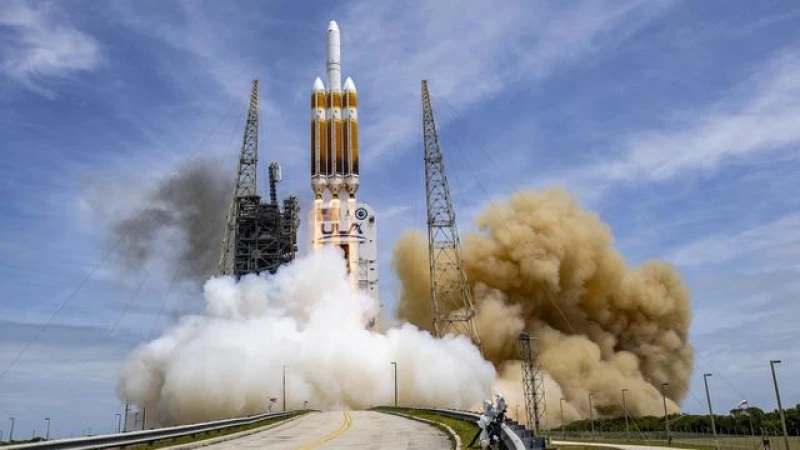Ending an era in U.S. rocketry, United Launch Alliance fired off its 16th and final triple-core Delta 4 Heavy Tuesday, launching a classified spy satellite in the last hurrah of a storied family of rockets dating back to the dawn of the space age.
The Heavy's three hydrogen-fueled RS-68A first stage engines ignited with a rush of bright orange flame at 12:53 p.m. EDT, smoothly pushing the 235-foot-tall rocket away from pad 37 at the Cape Canaveral Space Force Station in Florida.

The launch came 12 days late, primarily because of work to replace a pump in a system that supplies nitrogen gas to multiple launch pads from a pipeline running through the Kennedy Space Center and the Cape Canaveral Space Force Station. There were no problems Tuesday.
Mounted atop the rocket was a classified satellite provided by the National Reconnaissance Office, the secretive government agency that manages the nation's fleet of sophisticated optical and radar imaging reconnaissance satellites and electronic eavesdropping stations.
In keeping with standard NRO-U.S. Space Force policy for such missions, no details about the NROL-70 payload were released. But about six hours after launch, the National Reconnaissance Office declared the launch a success, indicating the satellite reached its planned orbit.
"As with all of our missions, they're focused on national security and delivering the best information, we believe, in the world for our policy makers, the warfighter and the civil community."
Based on the Heavy's easterly trajectory, safety notices and other factors, independent analysts concluded the payload most likely was an advanced signals intelligence satellite bound for a geosynchronous orbit 22,300 miles above the equator.
Satellites at that altitude appear stationary in the sky as they orbit in lockstep with Earth's rotation, allowing continuous observations of specific regions.
Such signals intelligence satellites are believed to feature giant mesh antennas that unfold in space, acting as "huge ... 'ears' in the sky, monitoring large areas for radio emissions, notably military (communications)," according to Marco Langbroek, an independent analyst based in the Netherlands.
As the classified mission unfolded, the launch coverage from ULA came to an end with the confirmation of second stage engine ignition and payload fairing separation seven minutes after liftoff. The subsequent part of the ascent was shrouded in secrecy.
Witnessing the final launch of a Delta rocket 63 years after the debut of the first variant marked an emotional milestone for the team of managers, engineers, and technicians who worked on assembling and launching the last member of the family.
"Launching the last Delta 4 brings mixed emotions for me," remarked Col. Eric Zarybnisky, director of NRO's Office of Space Launch, in a statement. "I was involved in the team that launched the initial Delta 4 for the NRO. Over time, the Delta 4 has delivered incredible capabilities into orbit for our nation."
Tory Bruno, the president and CEO of United Launch Alliance, echoed similar sentiments, describing the flight as a "bittersweet" moment as the company transitions to the next-generation Vulcan rockets, phasing out the more costly Delta and Atlas families.
"Soon, Vulcan will take on that responsibility as we bid farewell to this esteemed rocket that has undertaken vital missions for our country," he expressed in a post-launch video.
"A Farewell to Delta 4 Heavy"
As the Delta 4 Heavy takes its final bow, a bittersweet moment is shared among those who have been part of its journey. "I want to thank everyone who has been involved with the Delta 4 Heavy. We have many employees who were here for the very first Delta 4 launch who are still here now for the last Delta 4 launch to send off this great vehicle into its well-earned retirement."
The Delta family of stages and rockets has a rich history, with its origins tracing back to the early space program. Initially serving in the nation's fleet of intermediate-range ballistic missiles, the Delta family evolved through multiple versions used to launch military, NASA, and civilian payloads into orbit.
The now-retired Delta 2, which debuted in 1990, played a crucial role in various missions. It launched the first Global Positioning System satellites, sent multiple planetary probes into deep space, and contributed to missions such as Messenger to Mercury, Mars orbiters, the Pathfinder, Spirit and Opportunity Mars rovers, the Spitzer Space Telescope, and many more.
The single-core Delta 4 made its first flight in 2002, with the Heavy variant following two years later. The single-core version concluded its flights in 2019. The recent launch marked the 45th flight of a Delta 4 and the 16th and final flight of the Delta 4 Heavy.
"We are thrilled to partner with Vulcan and embark on these missions, yet our affection for the Delta rocket remains," Bruno expressed regarding the Delta family.
"Delta has had a presence in various forms for over 60 years," he continued. "It boasts a rich history and has made significant contributions to our country. We take great pride in being associated with its legacy, and although Vulcan represents the future, personally, I feel a sense of loss to bid farewell to Delta."







